
The Eyefinity EHR iPad application is built specifically for the touchscreen of an iPad and stores patient information securely in the cloud. The eye-tracking technology is smart enough to learn how to improve your practice, earning you an extra patient every day, as much as $350 per day. The system also allows patients to report their medical, family, and social history online before they visit you. It also integrates with OfficeMate workflow. With these features, Eyefinity EHR is a perfect choice for any practice.
Cloud-based electronic health records solution
In order to manage your patient’s medical information, you’ll need a good electronic health records software. Eyefinity EHR can help you get everything organized. The system helps you create an organized patient chart, automate workflow, and submit billing faster. Other features include HIPAA compliance, patient portal, secure data transfer, and lab integration. Eyefinity can be used by small practices and large multi-location hospitals alike, and it’s easy to learn and use. The software’s cloud-based hosting means that you won’t need to purchase servers or other hardware to use Eyefinity EHR.
This Cloud-based EHR solution includes a native iPad app that lets doctors use the device’s built-in features to manage patient information. The Eyefinity EHR Kiosk App allows patients to check-in and update their own personal information electronically. It integrates seamlessly with OfficeMate’s workflow, allowing your practice to use the same software to manage all of your patients. Eyefinity EHR is an electronic health records solution for eye care practices.
Compatible with existing practice management software
The Eyefinity EHR is a cloud-based electronic health record system that pairs seamlessly with Eyefinity Practice Management software. The system streamlines independent practices’ workflows, centralizes data across multiple locations, and streamlines optician orders. This software also includes a professional website that doctors can manage and automatically send appointments and notifications about eyewear availability. In addition, Eyefinity EHR is compatible with OfficeMate workflow.
The EHR software is designed with ophthalmologists in mind, and it focuses on workflow efficiency and automation. Workflows can be automated to document each patient’s exam records, update medical histories, and prescriptions. The system also sends final prescription information to OfficeMate, Eyefinity’s practice management software. The system also has a number of features that help optometrists stay up-to-date on Medicare and other regulations.
Cost
When looking to purchase an EHR system, the first question you should ask yourself is: Does Eyefinity EHR come with a license fee? This depends on how customized you want your system to be. This may require additional hardware and customization. Additionally, you should factor in the cost of maintenance and upgrades. While Eyefinity EHR has an annual subscription plan, you may want to consider a one-time purchase to reduce the cost per user.
The cost of Eyefinity EHR starts at $100 per provider, and includes training and customization. There are also hidden costs, such as migration of your existing data. ITQlick rates Eyefinity EHR’s price at 7.4 out of 10; you can determine the cost of your license by using the calculator below. Once you know the exact price of Eyefinity EHR, you can make a more informed decision about whether to purchase the software.
System requirements
The Eyefinity EHR requires an iPad with iOS 15 or later. If you’re transferring from another EHR, you must first select both certified products and all versions of Eyefinity EHR. You can also choose the lowest model of the iPad, though performance will suffer. Listed below are the requirements for OfficeMate. These requirements apply to all Eyefinity EHR systems. They must also be compatible with your practice management system.
The EHR web application lets you associate forms with patients, practice locations, and providers. Once you’ve entered the necessary information, you can filter the forms by name and category to quickly find the ones you need. You can also delete PDF forms from your EHR; however, this will prevent new ones from being created. Any existing documents will be left attached to patients. Once you’ve entered all the information you need for your EHR, you can view and edit diagnostic images easily.



